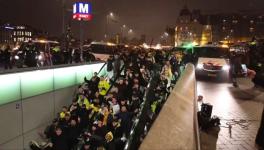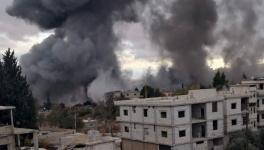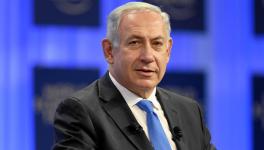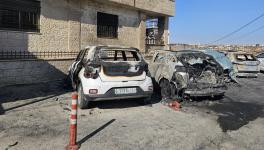Ceasefire Deal After Weeks of Fighting in Gaza Promises Rasing of Blockade
Israel and the Palestinian armed groups waging war in Gaza for the past seven weeks have inked a cease-fire deal that promises an end to the fighting. While the full terms of the deal have not been released, news outlets are reporting that the agreement includes an easing of the blockade of Gaza and the halting of attacks from both sides.
The reported terms of the deal are similar to the 2012 agreement that ended Israel’s last assault on Gaza, though that deal was never implemented. It remains to be seen whether a real easing of the blockade, the core demand of Palestinians, will take place. There was no mechanism for enforcing that 2012 agreement, and it doesn’t look like there will be a mechanism for enforcing this deal. Nevertheless, representatives of Palestinian parties are celebrating the deal as a victory, and people in Gaza have also taken to the streets in celebration.
“We have reached an agreement for a ceasefire according to the 2012 deal, which includes opening the borders, and bringing in building materials,” Islamic Jihad official Ziad Nakhallah told The Guardian‘s Harriet Sherwood and Patrick Kingsley, who is reporting from Cairo, where cease-fire negotiations have taken place during the war. The deal also reportedly includes the opening of the Rafah crossing between Egypt and Gaza, and an easing of restrictions on fishing off the Gaza coast. The Palestinian Authority will govern the Palestinian side of the Rafah crossing, a return to arrangements at the border before Hamas and Fatah fought a brief battle for control of Gaza in 2007. The buffer zone that eats up agricultural land in Gaza near the Israel border will also be eased.

Palestinians look out of their house, which witnesses said was damaged during the Israeli offensive, on the fourth day of a five-day ceasefire in Johr El-Deek village near the central Gaza Strip August 17, 2014. (PHOTO: REUTERS, Ibraheem Abu Mustafa)
Other key issues that Hamas demanded will be talked about in a month. Those include the release of Palestinian prisoners, an airport and seaport for Gaza and the transfer of funds from Qatar to government employees in Gaza that Israel has blocked. Hamas also is said to hold the remains of two Israeli soldiers, which potentially paves the way towards a prisoner swap.
In Israel, the reaction was much more dour. The deal was unilaterally agreed to by Prime Minister Benjamin Netanyahu without the consent of his cabinet. Netanyahu’s coalition partners–and political rivals–Naftali Bennett and Avigdor Lieberman oppose the cease-fire. The prime minister is sure to take a political beating in the aftermath of the war. His poll numbers have already dropped in recent days from 82 percent to 38 percent. And political officials in the south of Israel, which have borne the brunt of Palestinian rocket and mortar attacks, have harshly criticized the deal. “Any concession to Hamas is a surrender to terrorism,” the mayor of Ashkelon told Haaretz.
The cease-fire agreement concludes the fiercest round of fighting ever waged in Gaza. The Palestinian death toll over 50 days of war stands at over 2,100, most of them civilians, and over 11,000 injured. About 500 Palestinian children were killed. 64 Israeli soldiers and five Israeli civilians were killed by Palestinian factions. Many people have fled Israel’s southern communities.
The key question for many Palestinians in Gaza is rebuilding. Whole neighborhoods have been flattened by Israeli bombs and artillery fire. About 475,000 Palestinians are displaced and many are homeless.
Courtesy: mondoweiss.net
Disclaimer: The views expressed here are the author's personal views, and do not necessarily represent the views of Newsclick
Get the latest reports & analysis with people's perspective on Protests, movements & deep analytical videos, discussions of the current affairs in your Telegram app. Subscribe to NewsClick's Telegram channel & get Real-Time updates on stories, as they get published on our website.























